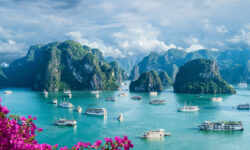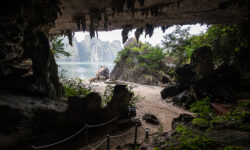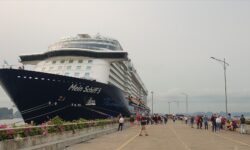Halong Bay, Lan Ha Bay, and Bai Tu Long Bay are three of the most stunning natural wonders in northern Vietnam. These three bays are situated in the same region of the country, near the city of Ha Long, and are recognized as UNESCO World Heritage Sites for their exceptional natural beauty and cultural significance.
Halong Bay, the largest of the three bays, is an awe-inspiring landscape of rugged limestone karsts and islets that rise dramatically out of the emerald waters. The bay covers approximately 1,500 square kilometers and boasts more than 1,600 limestone formations, many of which have been named for their unique shapes and features. Visitors to Halong Bay can enjoy a variety of activities, such as kayaking, swimming, and exploring the numerous caves and grottoes that dot the landscape. Despite its popularity, the beauty of Halong Bay is unparalleled and remains a must-visit destination for travelers from all over the world.

Lan Ha Bay, while smaller than Halong Bay, is equally as breathtaking in its own right. Covering approximately 700 square kilometers, Lan Ha Bay has a more tranquil and serene atmosphere than its larger neighbor. The waters of Lan Ha Bay are calm and crystal-clear, making it an ideal destination for swimming, kayaking, and other water-based activities. The bay also has numerous limestone formations, including Cat Ba Island, which is the largest island in the bay and home to a diverse range of flora and fauna. Visitors to Lan Ha Bay can explore the island’s lush forests and stunning beaches, as well as enjoy the many water-based activities on offer.

Bai Tu Long Bay, the smallest of the three bays, is a hidden gem that remains relatively untouched by tourism. Covering approximately 600 square kilometers, the bay is characterized by its unique blend of rugged and dramatic limestone karsts and islets, similar to Halong Bay, and its more peaceful and serene atmosphere, similar to Lan Ha Bay. Visitors to Bai Tu Long Bay can enjoy a variety of activities, such as kayaking, swimming, and cruising, while also experiencing the area’s unique culture and way of life. The bay is home to numerous fishing villages, where visitors can observe local fishermen and learn about their traditional way of life.

Despite their differences, all three bays share some similarities that make them equally as impressive. Each bay has an abundance of limestone formations that rise out of the turquoise waters, creating a breathtaking landscape that is sure to impress any visitor. Additionally, visitors to all three bays can enjoy a variety of water-based activities, such as swimming, kayaking, and cruising. The bays are also home to unique flora and fauna, including several endemic species, making them important areas for biodiversity conservation.
One thing to keep in mind when planning a trip to these bays is the crowds. Halong Bay is the most famous and popular of the three, attracting a large number of tourists each year. As a result, it can get quite crowded, especially during peak tourist season. In contrast, Lan Ha Bay and Bai Tu Long Bay are less crowded, making them a more peaceful and serene alternative to Halong Bay. Visitors looking to avoid the crowds should consider visiting Lan Ha Bay and Bai Tu Long Bay, which offer equally stunning scenery and a more authentic and secluded experience.
In conclusion, Halong Bay, Lan Ha Bay, and Bai Tu Long Bay are three of the most beautiful destinations in Vietnam, each with its unique features that make it a must-visit for travelers from all over the world. From the awe-inspiring limestone formations to the crystal-clear waters, visitors to these bays are in for an unforgettable experience. While they share some similarities, each bay has its own distinct character that sets it apart from the others. Halong Bay is the largest and most famous of the three, boasting a dramatic landscape of limestone karsts and a wide range of tourist activities. Lan Ha Bay, on the other hand, offers a more tranquil and serene atmosphere, with calm waters and stunning beaches, while Bai Tu Long Bay is a hidden gem that remains relatively untouched by tourism, providing a more authentic and secluded experience.
Despite their differences, all three bays are recognized as UNESCO World Heritage Sites for their exceptional natural beauty and cultural significance. Visitors to these bays can immerse themselves in the local culture and way of life, explore the diverse flora and fauna, and enjoy a variety of water-based activities. However, visitors should keep in mind the crowds, particularly at Halong Bay, which can get quite crowded, especially during peak tourist season.
In addition to the three bays, the surrounding area of Ha Long also offers a wide range of attractions and activities. Visitors can explore the nearby Cat Ba Island, home to a national park and a diverse range of wildlife, or visit the nearby floating fishing villages and observe the local way of life. The area also has numerous temples, pagodas, and other historical sites, providing visitors with a glimpse into the rich culture and history of northern Vietnam.
In conclusion, a trip to the bays of Ha Long is an experience that should not be missed. Whether you’re seeking adventure, tranquility, or a more authentic experience, Halong Bay, Lan Ha Bay, and Bai Tu Long Bay have something for everyone. With their stunning natural beauty, unique character, and cultural significance, these three bays are truly among the most beautiful destinations in Vietnam and the world.







